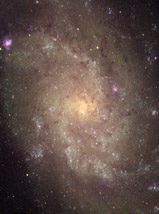| OIR Research: Edge-On Spiral Galaxies | ||||
|
Spiral galaxies that are seen edge-on to the line of sight provide
special opportunities to learn about the materials and structures that
extend out from the galaxy midplanes. This is because those components
are seen in projection against the very dark background, instead of
the very bright stellar disks. Observations of edge-on galaxies
therefore reveal large-scale features that would otherwise remain hidden,
like warps and tidal streams, as well as the distributions and ages of
stellar populations. All of these yield vital clues to these galaxies'
histories.
Scientific Publications A Study of Edge-On Galaxies with HST/ACS. II. Vertical Distribution of the Resolved Stellar Population .pdf Clues to Nuclear Star Cluster Formation from Edge-on Spirals .pdf High-Latitude H I in the Low Surface Brightness Galaxy UGC 7321 .pdf A Search for Faint, Diffuse Halo Emission in Edge-On Galaxies with Spitzer/IRAC
Links
People |

The disk of edge-on spiral galaxy NGC 891 as observed by
CfA Fellow Anil Seth with the HST at visible wavelengths.
With high-resolution HST imaging it becomes possible to
determine the structure of NGC 0891 using counts of individual stars.
The "Integral Sign Galaxy" (a.k.a. UGC3697) exhibits an unusually pronounced warp in both its stellar and gaseous disks. In this image, radio wavelength emission from the neutral atomic hydrogen gas (colored blue for display purposes) is overplotted on an optical image of the galaxy. The radio data were obtained with the Very Large Array of the National Radio Astronomy Observatory and the optical images were taken with the WIYN Telescope on Kitt Peak. The unusual appearance of UGC3697 has probably been triggered by an interaction with a small companion. | |||





